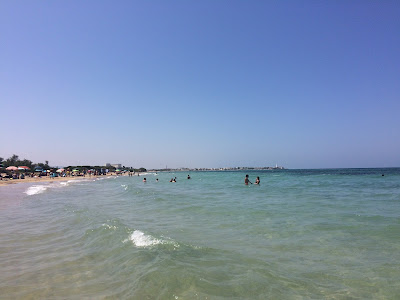Creamy slow-cooked risotto is a simple and economical Italian dish that dominates the cuisines in many of the regions. Although chicken and chorizo isn't particularly typical of Puglia, you can change the flavours once you have the basics down (think seafood risotto, zucchinni, porcini and so on). It's pretty easy to adapt, once the ingredients are chopped and thrown in it's just a matter of stirring it around until the liquid has been absorbed.
- 3 chicken breasts, diced
- 500g Arborio rice
- 150g Parmesan cheese, grated
- 300ml dry white wine
- 1.5L chicken stock
- 1 red onion, diced- 2 cloves garlic, chopped
- 1 large knob of butter
- 4tbsp of olive oil
- Salt and pepper for seasoning (a few pinches)
Method
 On a medium heat, warm the olive oil and butter in a large
pan and add the onion once it's hot. when the onion has softened (takes a couple of minutes), add the garlic. As the garlic turns golden, empty the packet of risotto into the pan and stir around until the rice becomes translucent. This seals in the flavour and takes between 5-10 minutes.
On a medium heat, warm the olive oil and butter in a large
pan and add the onion once it's hot. when the onion has softened (takes a couple of minutes), add the garlic. As the garlic turns golden, empty the packet of risotto into the pan and stir around until the rice becomes translucent. This seals in the flavour and takes between 5-10 minutes.
 While this is going on, add the chicken and chorizo to a hot
pan of oil and cook. Leave to the side until all the stock has been soaked by the rice (see previous steps) then add to the pan, along with the parmesan. Add the
rest of the white wine (150ml), cover and leave to simmer. We left it for about
10 minutes while we made a salad. Once the liquid has gone, it’s ready
to serve and eat!
While this is going on, add the chicken and chorizo to a hot
pan of oil and cook. Leave to the side until all the stock has been soaked by the rice (see previous steps) then add to the pan, along with the parmesan. Add the
rest of the white wine (150ml), cover and leave to simmer. We left it for about
10 minutes while we made a salad. Once the liquid has gone, it’s ready
to serve and eat!
Method
 On a medium heat, warm the olive oil and butter in a large
pan and add the onion once it's hot. when the onion has softened (takes a couple of minutes), add the garlic. As the garlic turns golden, empty the packet of risotto into the pan and stir around until the rice becomes translucent. This seals in the flavour and takes between 5-10 minutes.
On a medium heat, warm the olive oil and butter in a large
pan and add the onion once it's hot. when the onion has softened (takes a couple of minutes), add the garlic. As the garlic turns golden, empty the packet of risotto into the pan and stir around until the rice becomes translucent. This seals in the flavour and takes between 5-10 minutes.
Some schools of thought say that you should add all of the
stock at once and let it simmer until soaked. But traditionally it’s better
to add one cup at a time and stir until completely taken in because it helps
the starch dissolve and makes it creamier.
 While this is going on, add the chicken and chorizo to a hot
pan of oil and cook. Leave to the side until all the stock has been soaked by the rice (see previous steps) then add to the pan, along with the parmesan. Add the
rest of the white wine (150ml), cover and leave to simmer. We left it for about
10 minutes while we made a salad. Once the liquid has gone, it’s ready
to serve and eat!
While this is going on, add the chicken and chorizo to a hot
pan of oil and cook. Leave to the side until all the stock has been soaked by the rice (see previous steps) then add to the pan, along with the parmesan. Add the
rest of the white wine (150ml), cover and leave to simmer. We left it for about
10 minutes while we made a salad. Once the liquid has gone, it’s ready
to serve and eat!
By Simon Eggleston

















